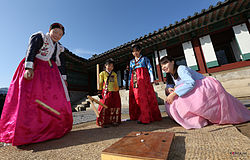| Seollal | |
|---|---|
 | |
| Also called | Seollal, Lunar New Year |
| Observed by | Korean people around the world |
| Type | Cultural |
| Significance | First day of the lunisolar calendar |
| Date | Typically the second new moon after the winter solstice |
| 2023 date | Sunday, 22 January |
| 2024 date | Saturday, 10 February |
| 2025 date | Wednesday, 29 January |
| Frequency | Annual |
| Related to | |
| Korean New Year | |
| Hangul | 설날 |
|---|---|
| Revised Romanization | Seollal |
| McCune–Reischauer | Sŏllal |
Seollal (Korean: 설날; RR: Seollal; MR: Sŏllal) is a Korean traditional festival and national holiday commemorating the first day of the lunisolar calendar.[1] It is one of the most important traditional holidays for ethnic Koreans, being celebrated in both North Korea and South Korea as well as Korean diaspora all around the world.[1][2]
Seol, written as "설" in Middle Korean in Hangul, means "year of age" since it is also the date when Koreans grow a year older, though in South Korea this has changed as of 2023.[3] The modern Korean word for "age" – sal is derived from the same origin as seol.[4] Nal 날 means day in Korean, derived from Old Korean *NAl. The Hanja term won-il (月日) is used, when referring to the date of the lunar new year of the Korean calendar itself. The Korean lunisolar calendar, like most other East Asian calendars such as those of Japan, Mongolia, Vietnam, among others, are all derived from historical variants of Chinese ones such as the Shixian calendar of the Ming dynasty. China and Japan use different terms for their respective new years, such as 正月 or 元日, which are derived from Classical Chinese.
During this time, many Koreans would visit their family, perform ancestral rites, wear the hanbok (한복; 韓服) / Chosŏn-ot (조선옷; 朝鮮옷), eat traditional food and play traditional folk games. One of the most well known practices in the current day is receiving money from their elders after performing a formal bow, a tradition likely adopted from Confucian customs.[5]
Seollal generally occurs in January or February on the second new moon after the winter solstice, unless there is an intercalary eleventh or twelfth month in the lead-up to the New Year. In such a case, the New Year falls on the third new moon after the solstice.[6]
- ^ a b "설". Encyclopedia of Korean Culture. Retrieved 22 January 2023.
- ^ Cite error: The named reference
EncyKoreawas invoked but never defined (see the help page). - ^ "How South Koreans woke up years younger". Al Jazeera. Retrieved 7 February 2024.
- ^ 우리말샘. opendict.korean.go.kr. Retrieved 22 January 2023.
- ^ Cite error: The named reference
visitkorea.or.krwas invoked but never defined (see the help page). - ^ Crump, William D. (2014). Encyclopedia of New Year's Holidays Worldwide. McFarland. pp. 134–135. ISBN 978-1476607481.